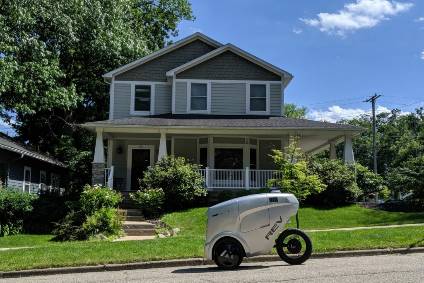
Meet REV-1, a food delivery robot developed by Ann Arbor-based start-up, Refraction. Founded by UMich professors and roboticists Matthew Johnson-Roberson and Ram Vasudevan, the company is solving the last mile challenge by making a low-cost, lightweight autonomous delivery robots that can operate in both the bike lane and on the roadway. Continuing our series of interviews at CES, we spoke to Matthew Johnson-Roberson to learn more about its food delivery robot.
Could you tell us a little about Refraction, how you started and who funds you?

Discover B2B Marketing That Performs
Combine business intelligence and editorial excellence to reach engaged professionals across 36 leading media platforms.
Refraction AI is mobility as a service company. In particular, our company has constructed a low weight, low cost, autonomous robot platform that is able to follow a user-specified route safely. Due to the size and form factor of the platform, it can operate either on the sidewalk, bicycle lane, or traffic within a several mile radii of a given origin. Our primary focus, currently, is on using this platform to perform delivery tasks.
Both Ram and I have been working on autonomous vehicles for more than a decade. We met each other while we were faculty members at the University of Michigan. At the University, we ran a large centre on autonomous vehicles. We soon later realized that, even though the car-sized autonomous vehicle problem may be years away from being fully solved, we can start tackling the smaller sized autonomous robot platform. We were in a position to be able to provide many of the benefits of autonomous vehicles without endangering lives. Once we realized this, they began working on developing a low-cost, low-weight autonomous robot platform and Refraction AI was born.
In the first few years, we bootstrapped and built the robot in my garage. Cold and dark, it was a great place to do physical hardware. Then this past March, we raised $2.5 million from eLab Ventures and Trucks Venture Capital.
What stage have you reached with REV-1 delivery robot?
December has been a fantastic month for us. We recently launched our first commercial food delivery service in Ann Arbor. Our customers can now sign up for our pilot program to place lunchtime delivery orders to have our robots deliver food to them. They can order from favourite local restaurants Miss Kim, Belly Deli, Tios Mexican Cafe, and Chow Asian Street Food carried out by our REV-1 robot – about the size of a bicycle that operates in the bike lane and the roadway.
How does the REV-1 work and what is its range?
Customers within a 2.5-mile delivery zone can place their lunch through our pilot programme.
Customers within a 2.5-mile delivery zone can place their lunch through our pilot program. That customer receives a confirmation with a unique code and delivery updates throughout the robot’s journey. When the REV-1 arrives outside the destination, the notified customer will meet the robot at the curb and grab their food with the unique code provided.
What are the materials and technology used in its construction and how much does it cost to build it?
The size and cost of our platform make it particularly amenable for delivery tasks. It costs about $4,000 to produce. Our design choices also allow us to operate with an inexpensive platform that can make our pricing far lower than our competitors. We designed our vehicle with 12 cameras, some with a vast field of view like 200 degrees, some more narrow like 90-100 degrees. All of these cameras help spread out the field of view, allowing us to see 360 degrees around the vehicle and perform depth estimation with a high level of fidelity that enables the vehicle to position itself with respect to parked cars and lanes. We also have sensors that make sure we’re being safe like an ultrasound that beeps in a car when things get close.
What is your business model? And how many deliveries does your robot need to make before it can break-even?
We have operators that overlook our av. One operator manages three vehicles but in time one operator will be able to manage up to six vehicles. Our teleoperators are highly competent, they go through an extensive training program and are provided with comprehensive manuals and resources. They work in shifts with no less than two people on at any given time. As we expand, we’re planning on keeping teleoperations in Ann Arbor because of our skilled workforce and lower operating costs.
How does REV-1 deal with giving way at zebra crossings?
Our vehicle moves slowly and is very light, similar to a small child riding a bicycle.
Our vehicle moves slowly and is very light, similar to a small child riding a bicycle, so the impact risk is very low. If something dashes in front of it, its sensor modalities – cameras, ultrasound, radar, LIDAR – pull it to a stop and because it’s so light and slow, our teleoperators can takeover quickly and safely. This addresses municipality concerns over having a human there if something goes wrong.
There are other ‘last mile’ autonomous solutions out there to move food using sidewalks. What makes yours any different?
While there are other ‘last-mile’ av solutions, we’re one of the few that can operate safely in bike lanes which allow us to operate much faster and over a much larger service area than our competitors who only operate on the sidewalk. However, our low weight makes it much more feasible for us to safely deploy our platform when we compare ourselves to our competitors building automobile sized autonomous vehicle platforms.
What’s next for Refraction?
In five years, I believe that Refraction will be safely performing deliveries for millions of customers throughout the world. In twenty years, I hope that Refraction will have built a platform that people can flexibly adapt for autonomy tasks which our founders may not have even initially imagined.






